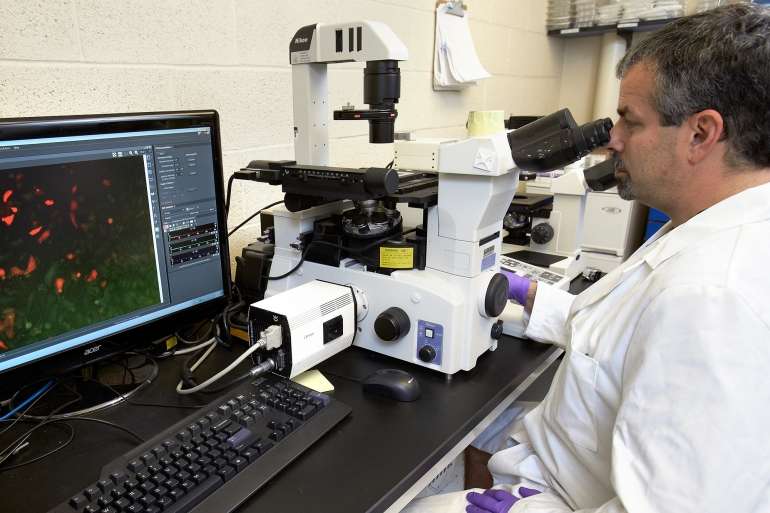Revolutionary gene-editing technique to stop AIDS virus in its tracks

Researchers with the Nevada Institute of Personalized Medicine at UNLV have engineered a new protein that they believe has placed science much closer to an HIV cure.
A patent application has been filed and testing is underway on the protein—called HT-TALENs (short for HIV-targeted transcription activator-like effector nucleases)—which uses a newly developed gene-editing technique to rid the body's cells of the immunodeficiency virus before it has a chance to multiply and possibly develop into AIDS. Here's how it works:
Humans infected with HIV have 1 million to 10 million cells harboring copies of HIV DNA. When HIV infects someone, the virus inserts itself into DNA cells and becomes part of those cells' permanent blueprint.
"Current drugs slow the virus from being produced, but they don't rid the body of the HIV DNA," said NIPM executive director and UNLV professor Marty Schiller. "You've got to get rid of or damage the harmful DNA to truly prevent the cells from creating the virus."
By altering a commonly used plant protein, Schiller's lab engineered the new HT-TALENs variation. Introduced into the body through a common cold virus injection, the protein adheres to the specific portions of DNA laden with HIV and acts as a pair of scissors that cuts or damages it without touching any of the non-infected DNA around it. When the cell repairs itself, the new copy won't contain functional HIV.
"This is a way we're getting at the root cause of AIDS—not going after a downstream event, but going after the actual DNA copy—and hopefully stopping virus replication in its tracks," Schiller said. "We think it has the potential to be a cure."
So far, the researchers have only produced results in petri dishes. They are awaiting patent approval and are gearing up to start on the next phase of testing this winter through a partnership with Brigham Young University. If that's successful, the scientists will move on to human trials.
Time frame for market use? Schiller hates to speculate, but if all goes well the best-case scenario is seven years.
"It's going to take a number of years to develop, but I'm pretty sure this approach should work and our goal is to lead the way," he said.
The protein treatment's success would be a boon emotionally and financially for patients undergoing current HIV drug regimens, which can top $15,000 a year.
Human tests would pair the new gene-editing protein therapy with current treatments. The protein might also be useful in curing other illnesses like bird flu.
The approach is revolutionary, Schiller said, considering that genetics—now widely used for prenatal screening and drug development—seemed a mere fantasy when referenced in the 1993 film Jurassic Park.
This project—one of about eight Schiller's lab is currently working on—began about three years ago after a weekly meeting of Schiller's team focused on current research papers. Schiller realized that the TALEN protein, derived from a wheat pathogen already widely used in the agriculture industry to genetically modify plants, described in one paper might be perfect after a few tweaks for use in HIV therapy.
The findings were published in the May issue of the peer-reviewed journal PLoS ONE.
Researchers included students with post-doctoral, graduate, and undergraduate status, and even some assistance by a local high school junior. Schiller said co-authorship in a major publication, especially on a project of this magnitude, is a major coup for young researchers. In fact, co-lead author Christy Strong, a former post-doctoral student, has since become a UNLV professor. The project inspired the other lead author, undergraduate Horacio Guerra, to switch career paths. He changed majors from a pre-med track to focus on scientific research. He graduated in the spring from UNLV with a bachelor of science in biology and is now in the graduate program at University of California, San Diego.
More information: "Damaging the Integrated HIV Proviral DNA with TALENs." PLoS ONE 10(5): e0125652. DOI: 10.1371/journal.pone.0125652




















